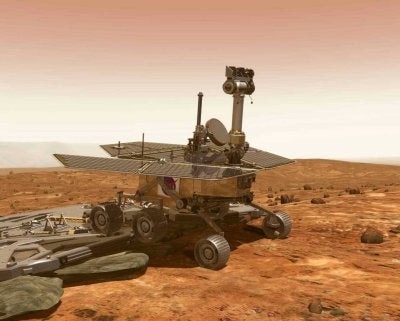“Electronics can fail from temperature cycling,” he says. “The temperatures the rovers are seeing range from 100° below zero Celsius to about 0° C [-150° to +32° F].”
Details matter, he says. “The Mini-TES has a lens assembly mounted on the mast. The interior of the rover is heated well,” he explains, but hardware outside the insulated electronics box, which is topped by the solar panels, is at risk.
Both rovers survived the winter, Matijevic notes. “In winter, the atmosphere is clearer, which is good for solar power,” he says, “but temperatures below -40° C [-40° F] are dangerous for our electronics.” So far, so good, he says, “We haven’t had to use the survival heaters — yet.”
That brings up the second rover-killer: power loss. The short winter days bring less overall power, calling for abbreviated activity in science and driving. “With the shorter days, we’ve had to drive into areas with preferential tilts toward the north,” explains Matijevic.
But as winter turns to spring, another problem arises: dust.
“We’re coming up on dust storm season,” Matijevich says. “The sunlight is reduced due to dust in the air, and dust also covers the solar cells.” Throughout the mission, Spirit, at a dustier site, has accumulated notably more dust than Opportunity.
Then in early March, engineers got a bonus house-cleaning for Spirit. A dust devil blew the solar panels clean, increasing power by 50 percent and bringing it back to a level not seen since about a month into the mission. The next day, Spirit’s cameras caught two dust devils spinning across the floor of Gusev, the first either rover had imaged. Since then, dust devils have been a common sight at Gusev.
Dust is more than a nuisance. It can foul machinery, jamming gears and other moving parts, thus leading to another cause of death — simple mechanical wear, a robot’s equivalent of old age.
Spirit’s right front wheel provided an unnerving example. The wheel’s motor began to use far more power than the others, indicating it was dragging. The problem was caused by lubricant that moved away from where it was needed. Mission controllers dealt with the difficulty by running Spirit in reverse about half the time, and directing Opportunity to do the same as a preventative measure.
But the wheels and drive train remain vulnerable. In April, Opportunity lost the ability to steer its right front wheel. While the impact on the mission appears relatively small, mssion controllers find it more difficult now to position the rover so it can use its instrument arm. And in the bigger picture, the deterioration is a sharp reminder that the original 3-month, quarter-mile warranty on each vehicle expired a long, long time ago.










